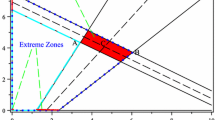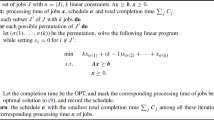Abstract
This paper is dedicated to a study of different extensions of the classical knapsack problem to the case when different elements of the problem formulation are subject to a degree of uncertainty described by random variables. This brings the knapsack problem into the realm of stochastic programming. Two different model formulations are proposed, based on the introduction of probability constraints. The first one is a static quadratic knapsack with a probability constraint on the capacity of the knapsack. The second one is a two-stage quadratic knapsack model, with recourse, where we introduce a probability constraint on the capacity of the knapsack in the second stage. As far as we know, this is the first time such a constraint has been used in a two-stage model. The solution techniques are based on the semidefinite relaxations. This allows for solving large instances, for which exact methods cannot be used. Numerical experiments on a set of randomly generated instances are discussed below.
Similar content being viewed by others
References
Cohn, A.M., Barnhart, C.: The stochastic knapsack problem with random weights: a heuristic approach to robust transportation planning. In: Proceedings from TRISTAN III. San Juan, Puerto Rico (1998)
D’Atri G., Di Rende A.: Probabilistic analysis of knapsack-type problems. Methods Oper. Res. 40, 279–282 (1980)
Dean, B.C., Goemans, M.X., Vondrak, J.: Approximating the stochastic knapsack problem: the benefit of adaptivity. In: FOCS ’04: Proceedings of the 45th Annual IEEE Symposium on Foundations of Computer Science, pp. 208–217. IEEE Computer Society, Washington, DC, USA (2004)
Fortet, R.: L’algèbre de Boole et ses applications en recherche opérationelle (1959)
Garey M.R., Johnson D.S.: Computer and Intractability. W. H. Freeman and Company, New York (1979)
Grötschel M., Lovász L., Schrijver A.: Geometric Algorithms and Combinatorial Optimization, volume 2 of Algorithms and Combinatorics. Springer, New York (1988)
Goemans M.X., Williamson D.P.: Improved approximation algorithms for maximum cut and satisfiability problems using semidefinite programming. J. ACM 42(6), 1115–1145 (1995)
Helmberg C., Rendl F.: Solving quadratic (0,1)- problems by semidefinite programs and cutting planes. Math. Program. 82, 291–315 (1998)
Helmberg C., Rendl F.: A spectral bundle method for semidefinite programming. SIAM J. Optim. 10(3), 673–696 (2000)
Helmberg, C., Poljak, S., Rendl, F., Wolkowicz, H.: Combining semidefinite and polyhedral relaxations for integer programs. In IPCO, pp. 124–134 (1995)
Helmberg C., Rendl F., Weismantel R.: A semidefinite programming approach to the quadratic knapsack problem. J Comb. Optim. 4(2), 197–215 (2000)
Ibarra O.H., Kim C.E.: Fast approximation algorithms for the knapsack and sum of subset problems. J. ACM 22(4), 463–468 (1975)
Kleywegt A.J., Papastavrou J.D.: The dynamic and stochastic knapsack problem. Oper. Res. 46(1), 17–35 (1998)
Laurent M.: A comparison of the sherali-adams, lovász-schrijver, and lasserre relaxations for 0-1 programming. Math. Oper. Res. 28(3), 470–496 (2003)
Padberg M.: The boolean quadric polytope: some characteristics, facets and relatives. Math. Program. 45(1), 139–172 (1989)
Pisinger D.: The quadratic knapsack problem-a survey. Discrete Appl. Math. 155(5), 623–648 (2007)
Rendl, F., Sotirov, R.: Bounds for the quadratic assignment problem using the bundle method. Technical report, University of Klagenfurt, Universitaetsstrasse 65–67, Austria (2003)
Sherali H.D., Adams W.P.: A hierarchy of relaxations between the continuous and convex hull representations for zero-one programming problems. SIAM J. Discrete Math. 3(3), 411–430 (1990)
Sherali H.D., Adams W.P.: A hierarchy of relaxations and convex hull characterizations for mixed-integer zero-one programming problems. Discrete Appl. Math. 52(1), 83–106 (1994)
Shmoys D.B., Swamy C.: An approximation scheme for stochastic linear programming and its application to stochastic integer programs. J. ACM 53(6), 978–1012 (2006)
Author information
Authors and Affiliations
Corresponding author
Rights and permissions
About this article
Cite this article
Gaivoronski, A.A., Lisser, A., Lopez, R. et al. Knapsack problem with probability constraints. J Glob Optim 49, 397–413 (2011). https://doi.org/10.1007/s10898-010-9566-0
Received:
Accepted:
Published:
Issue Date:
DOI: https://doi.org/10.1007/s10898-010-9566-0




